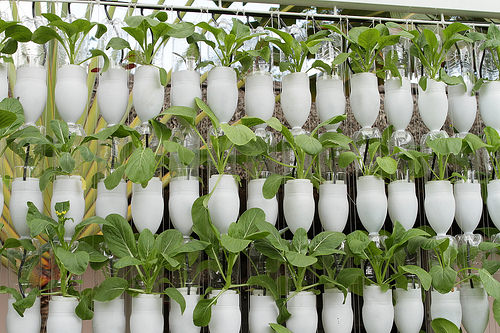You may be living in the middle of the metropolis with only a few square meters of space for a backyard or none at all, but this shouldn’t keep you from having your own vegetable “farm.” The technology that allows for this possibility is the Simple Nutrient Addition Program, or SNAP hydroponics.

Soiless farming
Hydroponics is the technique of growing plants without soil. It is not a new concept. This technique is believed to have been practiced in the famous hanging gardens of the ancient city of Babylon, which is considered one of the ancient world’s eight wonders.
In the modern day setting, hydroponics provides the long-term solution for vegetable production even under urban settings. With this, there is no issue of “in and off-season” farming because hydroponics system allows for uninterrupted farming.
Although hydroponics has been around for some time, it is only beginning to find its way into the Philippine farm setting. Hydroponics farms are already found in Cavite, and recently, in Clark Field, Pampanga. These hydroponics systems, however, were developed abroad making it expensive and unavailable for ordinary vegetable growers.
In a study conducted by Dr. Primitivo Jose Santos and Eureka Teresa Ocampo of the Institute of Plant Breeding (IPB), at the University of the Philippines Los Baños (UPLB), the scientists found that vegetables like lettuce, sweet pepper, celery, and cucumber can be successfully grown using a simple hydroponics system called SNAP hydroponics.
Low cost, low maintenance hydroponics system
Past experiments at the IPB made breakthroughs in using simple hydroponics systems where plants can be grown in a solution while using electrically-driven compressor pumps.
However, these systems that depend on the availability of electric supple become useless during power interruptions, which occur quite often in the country. Lack of power causes water-logging in the systems. The plants die if active aeration is not restored within the day.
This observation provided the impetus for the development, not only of a low-cost, but also a low-maintenance, passive aeration system.
SNAP hydroponics
The design of the snap hydroponics system is based on readily available materials found in a regular household. The system uses passive aeration, which does not require electricity.
There are four simple things needed to construct a SNAP hydroponics system: a seedling plug, the culture pots, the nutrient solution, and a shelter, which can be your house’s overhang roof.
Seedling plugs can be created using Styrofoam cups with holes at the bottom. To hold the plant in place, plug a bit of coconut coir dust at the bottom. Place a piece of net at the cut-off bottom to hold the coir dust and also to allow the roots to grow downward to the nutrient solution.
The culture pot is simply the container that holds the solution and the Styrofoam cups containing the seedlings. For the solution reservoir, get a box and line the bottom with polyethylene sheet to keep the solution from leaking. The lid of the box is used to hold the cups. Cut out holes on the lid, big enough to hold the Styrofoam cup by its neck.
The nutrient solution is made up of tap water and fertilizer mix. Some commercially available fertilizer mixes can be used in snap hydroponics. The mix is dissolved in water (the mix is 80-90% of final volume of the solution). The solution must be dissolved very well.
A shelter can be your garage or any place that provides sunlight and good aeration in your house because the system needs to be protected from the elements.
Setting up
Anchor two-week old seedlings in a coir dust plugged in the Styrofoam cups. Allow the roots to grow for a week by placing them in shallow trays with 1 cm-deep nutrient solution. When the root averages 1-2 cm, place the seedlings in the culture pots.
Submerge the bottom of the cups in the solution while the plants are at seedling stage. Once the roots become longer, decrease amount of solution in a way that a space is created between the bottom of the cups and the surface of the water. The space allows for passive aeration. This level of water is maintained as the plant grows.
One person can maintain the system, which can also be used year-round. Vegetables such as lettuce, sweet pepper, cucumber, and celery can be produced successfully in snap hydroponics. Cost and return analysis shows that this system is profitable, especially with leaf lettuce.
A basic premise to keep in mind about SNAP hydroponics is its simplicity. A modification of these simple principles allows for large scale vegetable production that can be done right in your backyard.
———————————————
Sources:
1. PJA Santos and ETM Ocampo. “Snap Hydroponics- A simple household-based production system for vegetables.” Institute of Plant Breeding, University of the Philippines Los Baños. 2001
2. Retrieved from the world wide web, at http://archimedes.galilei.com/raiar/histhydr.html (November 22, 2004)
By: Ma. Lizbeth J. Baroña, BAR Digest, October-December 2004 Issue (Vol. 6 No. 4)

Good day …. Im interested to take seminar for hydroponics. Im here in Las Pinas city. Could you please email to me your seminar schedule. My email address : boy.tadle@yahoo.com . Thank you and GOD BLESS
This might help for the meantime. Frequently asked questions about hydroponics here: https://www.greeneryretail.com/post/frequently-asked-questions-about-hydroponics